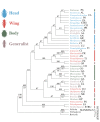Repeated adaptive divergence of microhabitat specialization in avian feather lice
- PMID: 22717002
- PMCID: PMC3391173
- DOI: 10.1186/1741-7007-10-52
Repeated adaptive divergence of microhabitat specialization in avian feather lice
Abstract
Background: Repeated adaptive radiations are evident when phenotypic divergence occurs within lineages, but this divergence into different forms is convergent when compared across lineages. Classic examples of such repeated adaptive divergence occur in island (for example, Caribbean Anolis lizards) and lake systems (for example, African cichlids). Host-parasite systems in many respects are analogous to island systems, where host species represent isolated islands for parasites whose life cycle is highly tied to that of their hosts. Thus, host-parasite systems might exhibit interesting cases of repeated adaptive divergence as seen in island and lake systems.The feather lice of birds spend their entire life cycle on the body of the host and occupy distinct microhabitats on the host: head, wing, body and generalist. These microhabitat specialists show pronounced morphological differences corresponding to how they escape from host preening. We tested whether these different microhabitat specialists were a case of repeated adaptive divergence by constructing both morphological and molecular phylogenies for a diversity of avian feather lice, including many examples of head, wing, body and generalist forms.
Results: Morphological and molecular based phylogenies were highly incongruent, which could be explained by rampant convergence in morphology related to microhabitat specialization on the host. In many cases lice from different microhabitat specializations, but from the same group of birds, were sister taxa.
Conclusions: This pattern indicates a process of repeated adaptive divergence of these parasites within host group, but convergence when comparing parasites across host groups. These results suggest that host-parasite systems might be another case in which repeated adaptive radiations could be relatively common, but potentially overlooked, because morphological convergence can obscure evolutionary relationships.
Figures





Comment in
-
How a bird is an island.BMC Biol. 2012 Jun 20;10:53. doi: 10.1186/1741-7007-10-53. BMC Biol. 2012. PMID: 22715854 Free PMC article.
Similar articles
-
How a bird is an island.BMC Biol. 2012 Jun 20;10:53. doi: 10.1186/1741-7007-10-53. BMC Biol. 2012. PMID: 22715854 Free PMC article.
-
Evolution of cryptic coloration in ectoparasites.Am Nat. 2010 Oct;176(4):529-35. doi: 10.1086/656269. Am Nat. 2010. PMID: 20722554
-
Host defense reinforces host-parasite cospeciation.Proc Natl Acad Sci U S A. 2003 Dec 23;100(26):15694-9. doi: 10.1073/pnas.2533751100. Epub 2003 Dec 12. Proc Natl Acad Sci U S A. 2003. PMID: 14673114 Free PMC article.
-
Feather mites (Acari: Astigmata): ecology, behavior, and evolution.Annu Rev Entomol. 2003;48:185-209. doi: 10.1146/annurev.ento.48.091801.112725. Epub 2001 Sep 28. Annu Rev Entomol. 2003. PMID: 12208818 Review.
-
Analytical approaches to measuring cospeciation of host and parasites: through a glass, darkly.Int J Parasitol. 2001 Jul;31(9):1012-22. doi: 10.1016/s0020-7519(01)00199-0. Int J Parasitol. 2001. PMID: 11406147 Review.
Cited by
-
The ectoparasites of hybrid ducks in New Zealand (Mallard x Grey Duck).Int J Parasitol Parasites Wildl. 2018 Sep 14;7(3):335-342. doi: 10.1016/j.ijppaw.2018.09.005. eCollection 2018 Dec. Int J Parasitol Parasites Wildl. 2018. PMID: 30258780 Free PMC article.
-
Antarctophthirus microchir infestation in synanthropic South American sea lion (Otaria flavescens) males diagnosed by a novel non-invasive method.Parasitol Res. 2019 May;118(5):1353-1361. doi: 10.1007/s00436-019-06273-2. Epub 2019 Mar 14. Parasitol Res. 2019. PMID: 30868295 Free PMC article.
-
Rensch's rule in avian lice: contradictory allometric trends for sexual size dimorphism.Sci Rep. 2019 May 27;9(1):7908. doi: 10.1038/s41598-019-44370-5. Sci Rep. 2019. PMID: 31133727 Free PMC article.
-
Genomic Approaches to Uncovering the Coevolutionary History of Parasitic Lice.Life (Basel). 2022 Sep 16;12(9):1442. doi: 10.3390/life12091442. Life (Basel). 2022. PMID: 36143478 Free PMC article. Review.
-
Competition, virulence, host body mass and the diversification of macro-parasites.J R Soc Interface. 2014 Feb 12;11(93):20131108. doi: 10.1098/rsif.2013.1108. Print 2014 Apr 6. J R Soc Interface. 2014. PMID: 24522783 Free PMC article.
References
-
- Simpson GG. The Major Features of Evolution. New York: Columbia University Press; 1953.
-
- Schluter D. The Ecology of Adaptive Radiation. Oxford, UK: Oxford University Press; 2000.
-
- Losos JB. Lizards in an Evolutionary Tree: Ecology and Adaptive Radiation of Anoles. Berkeley, CA: University of California Press; 2009.
Publication types
MeSH terms
LinkOut - more resources
Full Text Sources

